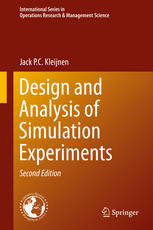

Most ebook files are in PDF format, so you can easily read them using various software such as Foxit Reader or directly on the Google Chrome browser.
Some ebook files are released by publishers in other formats such as .awz, .mobi, .epub, .fb2, etc. You may need to install specific software to read these formats on mobile/PC, such as Calibre.
Please read the tutorial at this link: https://ebookbell.com/faq
We offer FREE conversion to the popular formats you request; however, this may take some time. Therefore, right after payment, please email us, and we will try to provide the service as quickly as possible.
For some exceptional file formats or broken links (if any), please refrain from opening any disputes. Instead, email us first, and we will try to assist within a maximum of 6 hours.
EbookBell Team

0.0
0 reviewsThis is a new edition of Kleijnen’s advanced expository book on statistical methods for the Design and Analysis of Simulation Experiments (DASE). Altogether, this new edition has approximately 50% new material not in the original book. More specifically, the author has made significant changes to the book’s organization, including placing the chapter on Screening Designs immediately after the chapters on Classic Designs, and reversing the order of the chapters on Simulation Optimization and Kriging Metamodels. The latter two chapters reflect how active the research has been in these areas.
The validation section has been moved into the chapter on Classic Assumptions versus Simulation Practice, and the chapter on Screening now has a section on selecting the number of replications in sequential bifurcation through Wald’s sequential probability ration test, as well as a section on sequential bifurcation for multiple types of simulation responses. Whereas all references in the original edition were placed at the end of the book, in this edition references are placed at the end of each chapter.
From Reviews of the First Edition:
“Jack Kleijnen has once again produced a cutting-edge approach to the design and analysis of simulation experiments.” (William E. BILES, JASA, June 2009, Vol. 104, No. 486)